 |
World History
Is it Anti-Catholic to Celebrate
Guy Fawkes Night?
Marian T. Horvat, Ph.D.
What is this English holiday called Guy Fawkes Night celebrated every November 5 with public fireworks, large bonfires, roasted potatoes and toffee apples? It seems appropriate at this time of year to answer a few questions readers have asked about this English “holiday”.
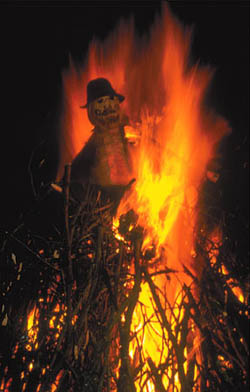
A 'guy' is burned in effigy in the bonfire; below, Guy Fawkes masks are popular items
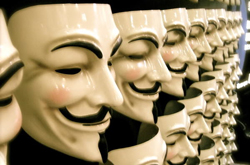 |
The main question is, “Is it anti-Catholic to celebrate Guy Fawkes Night?” On the huge bonfires, they usually burn a “guy” in effigy - the Catholic Guy Fawkes who was caught trying to blow up the houses of British Parliament in 1605 - but the British today say it is just part of the fun. They claim that Catholics join in the celebrations also since it was a day that thwarted a mass murder.
Briefly, what happened is that on the night of November 4, 1605, a plan of English Catholics to kill King James I and Parliament members was cut short by the arrest of Guy Fawkes, who was charged with placing gunpowder under the Houses of Parliament. The next day, November 5, Londoners were encouraged to celebrate the King's escape and “Protestant victory” by lighting bonfires in public celebrations. An Act of Parliament designated November 5 as a day of thanksgiving for "the joyful day of deliverance." Soon afterwards, fireworks were added to the celebrations.
Although Guy Fawkes is the one most associated with the November 5 “Gunpowder Plot,” he was only one of 13 in the Catholic group. Most people today do not even realize Guido Fawkes – his real name – was not the leader of the plot; the leader was Robert Catesby. Only at the end of the 18th century did Fawkes become the national villain and focus of the Bonfire Night. Before that, the Pope was the target burned in effigy while Robert Catesby was more frequently named and blamed in the Anglican sermons that memorialized the date the plot was foiled.
The celebration of Guy Fawkes Day in England on November 5 is most definitely a Protestant “holiday” and was conceived as a strong anti-Catholic manifestation. On that evening, it used to be common practice for Protestants to pull pranks on Catholics, some of them quite violent. Although today it is usually a figure of Guy Fawkes that is burned in effigy, in some parts of Britain, such as Lewes near Brithon, the “Bonfire Boys” still parade through the streets in costume with torches to burn a papal effigy alongside the “guy.” These are some considerations that Catholics should take into account before naïvely participating in the supposedly secularized Guy Fawkes Night.
Guy Fawkes Night in America
Why wasn’t the night celebrated in America? In fact, it was in many of the New England colonies, where it was sarcastically called “Pope Day.” However, in 1775, during the Revolutionary War, Continental army Commander George Washington forbade his troops’ planned celebration of that anti-Catholic holiday because he was trying to win French Canadian Catholics to the Patriot cause.
In his general orders for the day of November 5, Washington forbade “that ridiculous and childish custom of burning the effigy of the pope,” part of the traditional British celebration. He went on to express bewilderment that there could be “officers and soldiers in this army so devoid of common sense” that they would partake in such “monstrous” actions that could insult the religion of the Canadian Catholics, who were needed allies. (1)
Because the British descendants loved their November 5 bonfires, games and pranks, these customs continued in the New England States, but were transferred to Halloween night, which became the alternative “American” Guy Fawkes Day without its anti-Catholic connotations. This played a significant role, however, in secularizing All Souls’ Day in the United States, changing it from a Catholic holy day into a secular holiday.
Catholic persecution in England
Here is the history of this day celebrated by all Protestants and mourned by many Catholics.
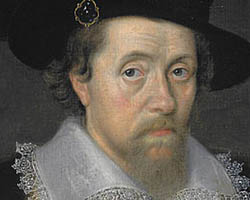
James I renewed persecution of Catholics |
In 1605 Queen Elizabeth died without an heir and was succeeded by the Protestant James of Scotland. English Catholics felt themselves unjustly oppressed and persecuted by the recusancy laws installed under Elizabeth. Recusants were those who refused to attend Anglican services; the "Recusancy Acts” imposed punishments including steep fines, property confiscation, and imprisonment. Catholics by law were also excluded from any post in national or local government, and were forbidden to travel five miles from their place of residence without permission from neighboring magistrates. It is sad to say, but these political and financial constraints were the cause for many lords and farmers - who otherwise would be Catholic - to give up the struggle and conform.
At first, James had appeased the Catholics by renewing diplomatic ties with Rome and implementing a plan of toleration. Catholicism would be tolerated, so long as Catholics pledged their loyalty to the king and their numbers kept in check. But the sudden rush of formerly hidden Catholics flocking to Masses that were no longer suppressed raised alarm among the Protestants. To appease them, James abruptly changed his policies.
In February 1604 a proclamation ordered all priests to leave the country; in August several were hanged for saying Masses. In November recusancy fines were vigorously resumed.
The Gunpowder Plot
The plan to blow up the Parliament building on November 5 during the State opening was conceived by Robert Catesby, a dashing and courageous young man from a notable Catholic family that had suffered greatly for the Faith. When no hope remained for tolerance under James, he resolved to lead a plot to overthrow the government by blowing up the Parliament and the King. Then Princess Elizabeth - the young daughter of the King who would hopefully show more tolerance toward the Catholic faith - would be installed on the throne.
Catesby and the group of Catholics who joined the Gunpowder Plot felt that “the nature of the disease required so sharp a remedy,” and that the Plot was a morally justifiable “act of self-defense against the oppressive rule of a tyrant.” (2)
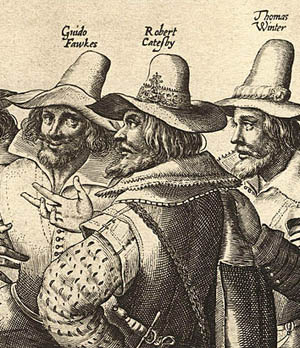
Three of the conspirators, including Catesby & Fawkes |
Among the group was Guido Fawkes, a soldier skilled in engineering and knowledgeable in explosives. He was to direct the tunneling toward the foundation of the Parliament building from the cellar of a nearby building, which promised to be a long and difficult task. This plan changed, however, when Fawkes discovered an empty lumber room immediately below the House of Lords available for lease. The room was rented, and the group moved 36 barrels of gunpowder into it, concealed under piles of firewood.
The powder was in place, the meeting of Parliament and the King was set, and it seemed the course of English history would change. The only thing required was secrecy until the appointed hour. This was the weak point of the plot. Some of the Catholics decided to send a letter warning Baron Monteagle, who was sympathetic to the Catholic cause, to find an excuse not to attend the Parliament’s opening.
Baron Monteagle informed the Earl of Salisbury, a leading minister of James I.
On November 4, the Earl of Salisbury called for a thorough search of the building, and Fawkes was discovered in the leased room with the hidden explosives. He was questioned, and the officer left. Instead of fleeing, the iron-nerved Fawkes remained, hoping he would still have a chance to carry out the plan. It was not to be. Almost immediately, the King’s men returned, searched the room and found the explosives. Fawkes was arrested and the plot was foiled.
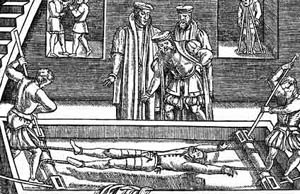
The rack was used against Fawkes; below, his signature before and after the torture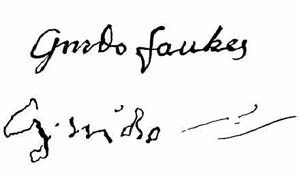 |
Fawkes was imprisoned in the Tower of London. Robert Catesby and three others were shot by troops ordered to capture them. In the Tower Guy Fawkes was repeatedly tortured until he yielded to the Council his identity and the names of those involved in the plot, and signed a confession. A broken scrawl – different from his normal elegant handwriting – is all he could manage after his body had been broken on the rack.
At their trial, Fawkes and the other Catholics were convicted of high treason and ordered to be hanged, drawn and quartered. On February 1, Fawkes was led to the scaffold with the others. He asked for forgiveness of the King and State, while keeping up his “crosses and idle ceremonies,” as Protestant chronicles disdainfully record. (4) In a last act of defiance, Fawkes jumped from the scaffold, breaking his neck in the fall. He was still drawn and quartered before the crowd.
In the next months, others who were only minorly involved in the plot were also arrested and executed. Some of these Catholics were completely innocent or just victims of circumstance.
As noted above, November 5 – only later named Guy Fawkes Night – became a national event to celebrate Protestant patriotism. Not surprisingly, Catholic Britons have always been uncomfortable with November 5, and there have been frequent calls to pass a parliamentary act to abolish the event. However, it seems it might not be necessary. The Americanized Halloween with its bonfires and trick-or-treating seems to be replacing the Guy Fawkes Night in many parts of Britain today, just as it did in the colonial America during the Revolution, as mentioned above.
1. http://the-american-catholic.com/2010/11/05/remember-remember-2/
2. Dennis Behreandt, “The Real Guy Fawkes,” The New American, Vol. 23, No. 26, December 24, 2007. Pp 33-39.
3. Ibid.
4. “Guy Fawkes,” Wikipedia

Posted November 7, 2011

Related Topics of Interest
 Let None Dare Call it Liberty Let None Dare Call it Liberty
 The Burning of the Ursuline Convent by Protestants The Burning of the Ursuline Convent by Protestants
 John Calvin, the Tyrant of Geneva John Calvin, the Tyrant of Geneva
 Genocide in Catholic Vendée Genocide in Catholic Vendée

Related Works of Interest
|
|
History | Home | Books | CDs | Search | Contact Us | Donate

© 2002- Tradition in Action, Inc. All Rights Reserved
|
 |
|